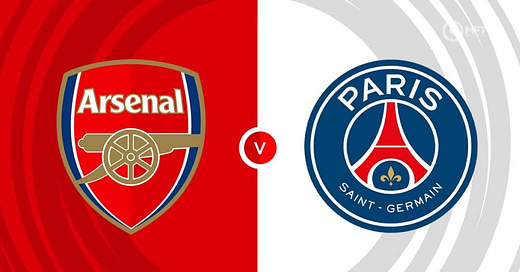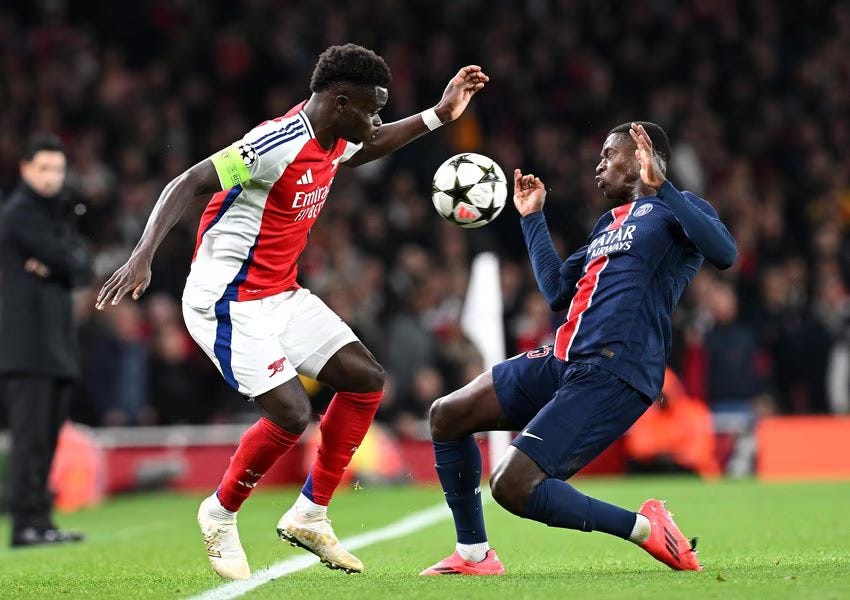Arsenal vs Psg: Post Match Report
The UEFA Champions League semi-final first leg in London was an electrifying showdown. Both teams fought, but PSG struck early and set the tone, proving that in football only goals matter.
At the Gunners’ Fortress, it’s the French Who Fire First: PSG Strike Early and Set Sights on Munich with 1-0 Win
Not even five minutes into the game and the game plan had to change, as PSG scored right away. As the first half progressed, the tempo slowed down—a situation that suited the Parisians perfectly, as they had hoped to control the match in exactly this manner and managed to maintain it throughout. The game began to resemble a chess match more than a football contest, with the key battles clearly taking place between the wingers and opposing fullbacks. These one-on-one matchups were also crucial in attack, particularly for Arsenal, whose fullbacks often tucked inside. These inward runs were vital to bypass the first line of PSG’s pressing and allowed Arsenal to carry the ball into space effectively.
The second half opened with Arsenal trying to catch PSG off guard immediately after the break. They even found the net through a set piece, but the goal was ruled out for offside. From then on, Arsenal struggled to create chances through their buildup play. PSG, in turn, began to tire them out by switching play, stretching the field, and dictating a slower tempo—a strategy they executed brilliantly. Defensively, PSG were relentless, never stopping their pressing and movement for a second. Luis Enrique seemed to get the most out of his players—even in aspects that aren't typically their strengths. As time wore on, substitutions started to make an impact on both sides. Arsenal, lacking depth on the bench, began to fade physically, while PSG's substitutes—particularly Barcola and Gonçalo Ramos—brought fresh energy and nearly scored, with one shot even hitting the woodwork. The game ended 1-0, with no further goals, leaving everything to be decided next week in what promises to be a battle at the Parc des Princes.
A strange night for Gunners Wonderboy
A final and important mention goes to the notable absence of Bukayo Saka's influence in the second half. Arsenal’s star winger appeared fatigued, and although he had a solid first half—showcasing his dribbling ability and even creating a few chances—he was largely invisible after the break. His physical drop-off clearly impacted Arsenal's attacking threat.
Some Tactical insights:
The Cut-in from the fullbacks, the only solution Arsenal managed to pull off
The animation also sheds light on the few moments when Arsenal were able to find any sort of offensive rhythm—and nearly all of them stemmed from one recurring pattern: the cut in runs of the full backs Timber and Lewis-Skelly. their aggressive movements from the wide channel into the space became Arsenal’s only reliable way to break through PSG’s suffocating press. These inside cuts allowed them to bypass the first pressing line, carry the ball centrally, and either link up with midfielders or draw fouls in dangerous areas. Even when these moves didn’t result in clear-cut chances, they often earned Arsenal set pieces—a crucial asset for the Gunners this season, as they’ve become one of the most efficient teams in Europe at capitalizing on dead-ball situations. In a match where space and time on the ball were luxuries, even winning a corner or a wide free-kick felt like a minor tactical victory.
Defensively, Arsenal responded to PSG’s fluid and chaotic front line by gradually settling into a more compact 4-4-2 out of possession. This mid-to-low block was designed to reduce the open spaces that PSG’s attackers love to exploit and to make their off-ball movements more traceable. By monitoring PSG’s shape more closely with this adjustments, it became easier for Arsenal to mark man-for-man when needed and maintain a more disciplined structure. However, this tactical adaptation came too late. The goal had already been conceded by the time Arsenal fully adjusted to PSG’s attacking dynamics. The early stages of the match saw the Gunners too exposed—caught between trying to press all the way and being drawn into remaining in position to avoid one on one duels in which the French were favored, especially given the speed and intelligence of their front line.
Animation is to be seen in 2x speed
Three Anchors and Controlled Chaos: How PSG Broke Through to Create and Score
The animation illustrates how PSG, once in possession, transition into a back three, with Achraf Hakimi pushing forward from his right-back position to operate almost as a fifth midfielder. On the opposite flank, Kvara—nominally the left winger in a 4-3-3—drops deeper to complete that midfield five, creating numerical superiority in central areas. This structural shift allows PSG to dominate possession and commit more players forward, putting Arsenal under constant pressure. The Gunners are repeatedly forced into uncomfortable one-versus-one defensive scenarios all over the pitch.
Crucially, these isolations are never favorable for Arsenal. If they choose to press higher and force PSG to play short, they are pulled into direct duels where the Parisians' dribbling ability shines—each of the front three is technically gifted and capable of beating their man. On the other hand, if Arsenal opt to sit deeper or allow more time on the ball, PSG stretch them vertically with long balls into space. That, too, is dangerous: the sheer pace of PSG’s attack makes tracking back a nightmare, especially with such fluid movement up front. The absence of a fixed number nine only compounds the problem—players constantly interchange, dragging defenders out of position and disrupting Arsenal’s defensive organization. Without a reference point, every movement has to be followed with maximum focus, and any hesitation can completely unravel the shape. This precise mechanism indeed leads to the breakthrough goal as the defender failed to follow PSG “number 9” when he dropped back in order to receive the ball at the halfway line.
Interestingly, João Neves seemed to anticipate all of this in his pre-match interview. His remark—“The less time they have to breathe, the better”—proved prophetic. PSG’s relentless pressing, especially from the first line, suffocated Arsenal’s buildup from the very start. Their inability to progress the ball cleanly or establish any consistent attacking rhythm through buildup meant that clear-cut chances were rare. Neves’ words captured the tactical essence of the match: by denying Arsenal time and space, PSG not only dominated possession phases but also neutralized their opponents’ offensive potential.







